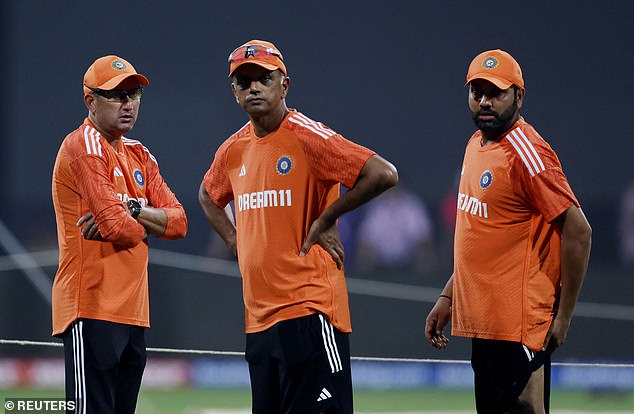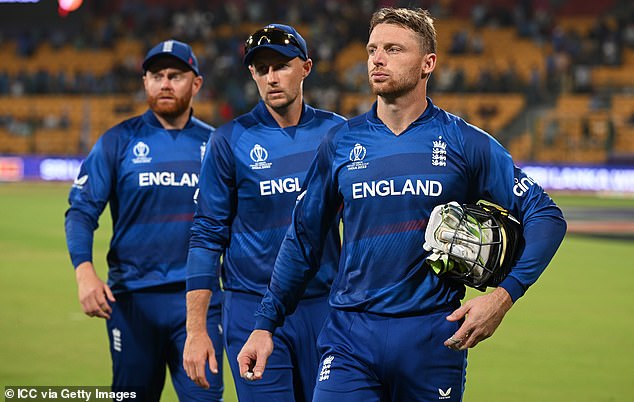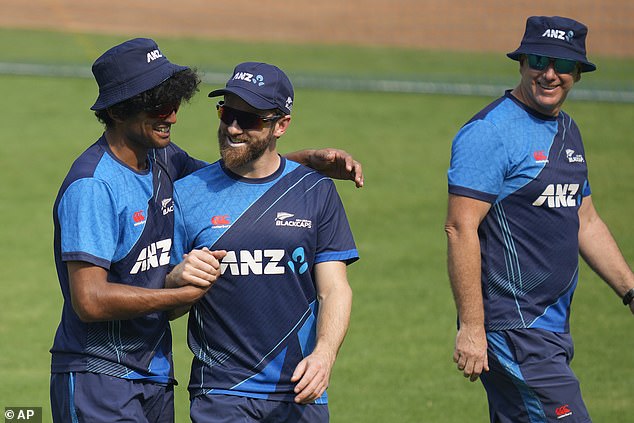Forget the Big Three, try the Big One… India RUN cricket now and the rest of the world is too spineless to take them on
It is perhaps the most misleading expression in the world of cricket: the Big Three.
England and Australia certainly have influence and are financially more secure than almost everyone else. But Mail Sport’s revelation that Indian authorities have made a change of tune for Wednesday’s semi-final between India and New Zealand in Mumbai is just the latest reminder that the phrase needs updating. Try the Big One.
At first glance, a pitch switch might not seem like a big deal: It’s still 70 feet, two sets of stumps, bat to ball.
But there’s a reason why the Board of Control for Cricket in India – and any other host board at a global event – is supposed to allow the ICC’s pitch consultant, Andy Atkinson, to do his job without fear or favor . And it’s simple: whatever inequalities exist beyond the border, the playing field itself must be as level as possible.
However, with the semi-final taking place on a surface that has already been used twice, India’s top players risk getting an advantage they hardly need.
Rohit Sharma inspects the surface ahead of the semi-final after Mail Sport revealed Indian authorities had forced a change of pitch ahead of the match with New Zealand

It shows that the expression of the Big Three in cricket (comprising India, England and Australia) needs to be changed to the Big One.
New Zealand has a world-class white-ball spinner of its own: left-armer Mitchell Santner has taken 16 wickets in this World Cup, at 24 apiece. But their other two slow bowlers – Glenn Phillips and Rachin Ravindra – are largely part-timers.
India, on the other hand, can boast of slow left-armer Ravindra Jadeja, who has taken 16 at the age of 18, and left-arm wrist spinner Kuldeep Yadav, who has 14 at the age of 22. Waiting in the wings is Ravichandran Ashwin, one of the greatest players. spinners in the history of the game.
So, strategically, it makes sense to work around the potential problem of playing on a new field against New Zealand’s strong seam attack.
And the problem is that the ICC can’t do anything about it – especially because the ICC is a mirage, an event management company that is the sum of its constituent members and dependent on its most powerful.
No one doubts that India funds world cricket. Every visit by the national team means that the home team can breathe a financial sigh of relief. Their huge population – 1.43 billion at the latest estimate, putting it a step ahead of China – means that cricket can often make big claims about its popularity.
But with power comes responsibility, which India generally exercises at its discretion.
The argument that India can now do the same because England and Australia used to run the game as they saw fit is as disingenuous as it is depressing. Others argue that criticism of the BCCI is borne out of jealousy, which is a lame and transparent way of shutting down the debate.
And usually it works. No one says a word, not even in public, because everyone is afraid to bite the hand that feeds him.

The argument that India can now do the same because England and Australia used to run the game as they saw fit is as disingenuous as it is depressing.
Some of the self-affirmation is subtle. In the last three World Cups in the two white-ball formats, the final group matches have involved only India, and against the Netherlands, Zimbabwe and Namibia – useful, one might think, for a late and specific boost in the net run. rate.
In particular, self-confidence is evident, typified by the non-stop growth of the Indian Premier League, whose tentacles have expanded into foreign leagues with regular teams controlled by IPL owners.
We may be just a few years away from players signing 12-month contracts with Mumbai Indians and Chennai Super Kings instead of their home boards. International cricket might as well give up after that, with the exception of a handful of major Test series and World Cups.
Also, don’t forget that the BCCI bans their players from participating in any T20 domestic tournament other than the IPL. Traffic is very much in one direction.

India should be able to beat New Zealand (pictured) even if they played on a glass plate
Cricket without India would be a fraction of the sport it has become, and the passion of their fans in a tournament that has given them nine wins out of nine has added to the sense of destiny.
But India also has the power to ensure that cricket thrives beyond its borders, flourishing at international level, as well as among T20 franchises. The entire sport will benefit from looking outward, not inward, and focusing on the bigger picture rather than fiddling with the details.
And let’s face it, whether they play on a sheet of glass or on the surface of the moon, India should be able to beat New Zealand.
